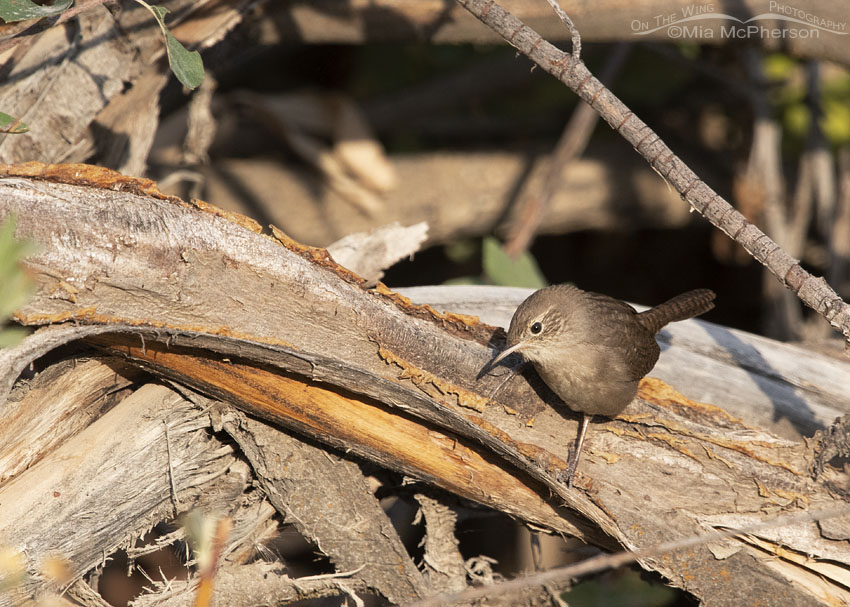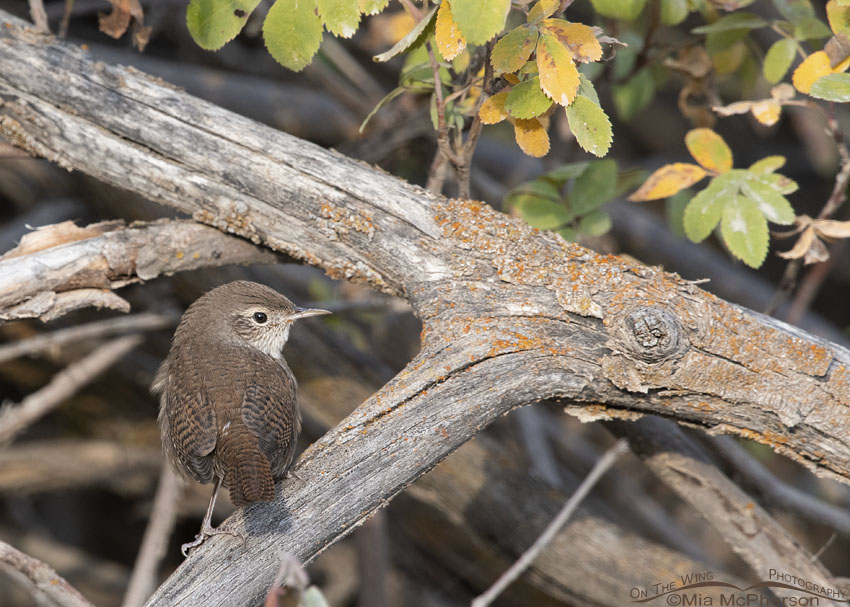Sometimes I wonder how birds get their common names, for instance I know House Wrens are a common yard bird but in my experiences with these tiny dynamos I find them more often in forested areas so why not Forest Wren instead of House Wren? Forests were here before there were houses or yards.
Forest Wren has a nice, descriptive ring to it whereas House Wren sounds rather pedestrian and doesn’t describe these small wrens well at all. Okay, enough rambling on about my thoughts on the common name of House Wrens…
 Inquisitive House Wren on a brush pile – Nikon D500, f7.1, 1/800, ISO 800, Nikkor 500mm VR with 1.4x TC, natural light
Inquisitive House Wren on a brush pile – Nikon D500, f7.1, 1/800, ISO 800, Nikkor 500mm VR with 1.4x TC, natural light
Yesterday morning I was delighted to find two House Wrens foraging in a brush pile in the Wasatch Mountains not long after sunrise. This time of the year the wrens aren’t singing like they do in the spring so I have to rely more on my eyes and not on a combination of my eyes and ears to locate them.
These wrens were moving in and out of view as they poked around the fallen branches and twigs looking for their breakfast. This one stopped foraging long enough to cock its head which appeared to be an inquisitive look in my direction though it most likely wasn’t inquisitive about me at all.
 House Wren foraging in a brush pile – Nikon D500, f7.1, 1/800, ISO 800, Nikkor 500mm VR with 1.4x TC, natural light
House Wren foraging in a brush pile – Nikon D500, f7.1, 1/800, ISO 800, Nikkor 500mm VR with 1.4x TC, natural light
Then the wren poked around the peeling bark on the fallen branches, it was probably looking for insects, insect eggs or possibly spiders. If it were me leaning as far forward on a sloping branch as this wren did I would fall flat on my face.
 House Wren in the Wasatch Mountains – Nikon D500, f7.1, 1/320, ISO 800, Nikkor 500mm VR with 1.4x TC, natural light
House Wren in the Wasatch Mountains – Nikon D500, f7.1, 1/320, ISO 800, Nikkor 500mm VR with 1.4x TC, natural light
The second Wren wasn’t too far away from the first and it perched out in the open long enough for me to take several photos of it too. The only way I could tell them apart was that this wren had a lighter colored throat than the first wren. When it perch near a crook in the fallen branch I had to photograph it and the lichen on the branch added a nice pop of color.
 Back view of a House Wren on a brush pile – Nikon D500, f7.1, 1/320, ISO 800, Nikkor 500mm VR with 1.4x TC, natural light
Back view of a House Wren on a brush pile – Nikon D500, f7.1, 1/320, ISO 800, Nikkor 500mm VR with 1.4x TC, natural light
I like how this back view of the House Wren shows off all of the patterns in the tail, back and wings of this species. In both of these last two images signs of fall show in the changing colors of the wild rose leaves. Before much longer these House Wrens will begin their migration so I am especially happy to have had great views of these wrens this late in the summer.
Life is good.
Mia
Click here to see more of my House Wren photos plus facts and information about this species.


Such a pretty little bird, whatever it is called.
And don’t get me started on the laziness/silliness of those who were given naming rights. As one example, your magpie is different to our magpie, and both are different to the UK version. They aren’t even from the same family.
Stunningly beautiful pics! Love the seemingly touchable detail and marvelous composition. Thanks Mia.
Lets gang together and vote for a name change!
Interesting post and wonderful images. The name issue made me go to Wikipedia for more information:
The house wren (Troglodytes aedon) is a very small songbird of the wren family, Troglodytidae. It occurs from Canada to southernmost South America, and is thus the most widely distributed bird in the Americas. It occurs in most suburban areas in its range and it is the single most common wren. Its taxonomy is highly complex and some subspecies groups are often considered separate species.
I totally agree with you about the name, House Wren, and was having that very same thought as I started to read your post. I like the way you put it.
Thank you for your posts and comments. I so enjoy them